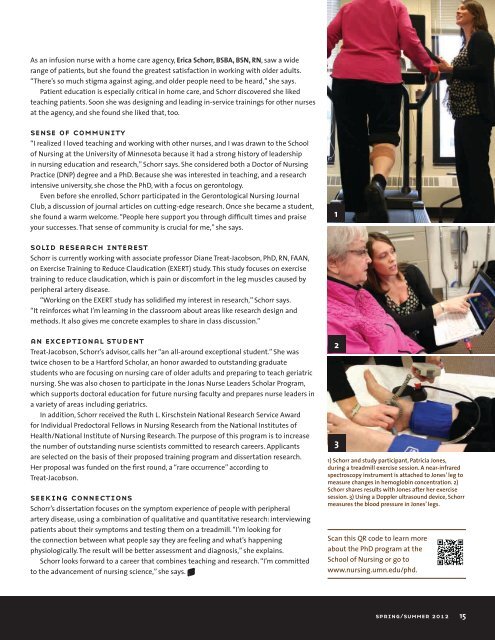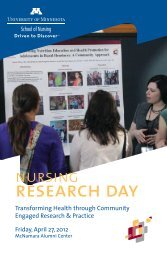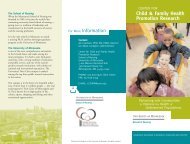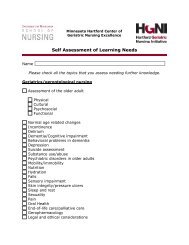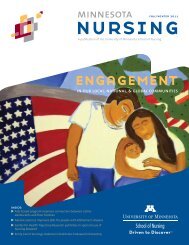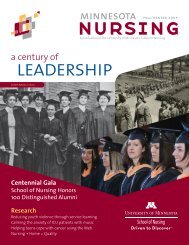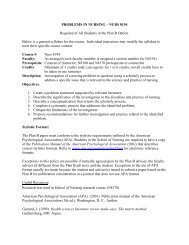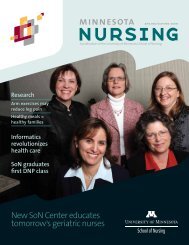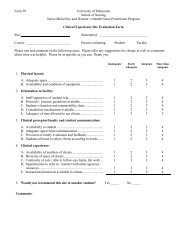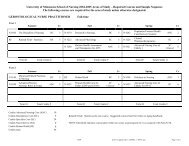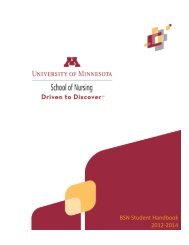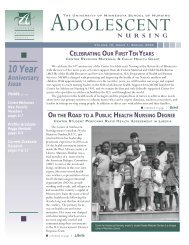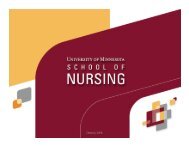Minnesota Nursing Magazine Spring/Summer 2012 - School of ...
Minnesota Nursing Magazine Spring/Summer 2012 - School of ...
Minnesota Nursing Magazine Spring/Summer 2012 - School of ...
Create successful ePaper yourself
Turn your PDF publications into a flip-book with our unique Google optimized e-Paper software.
As an infusion nurse with a home care agency, Erica Schorr, BSBA, BSN, RN, saw a wide<br />
range <strong>of</strong> patients, but she found the greatest satisfaction in working with older adults.<br />
“There’s so much stigma against aging, and older people need to be heard,” she says.<br />
Patient education is especially critical in home care, and Schorr discovered she liked<br />
teaching patients. Soon she was designing and leading in-service trainings for other nurses<br />
at the agency, and she found she liked that, too.<br />
sense <strong>of</strong> community<br />
“I realized I loved teaching and working with other nurses, and I was drawn to the <strong>School</strong><br />
<strong>of</strong> <strong>Nursing</strong> at the University <strong>of</strong> <strong>Minnesota</strong> because it had a strong history <strong>of</strong> leadership<br />
in nursing education and research,” Schorr says. She considered both a Doctor <strong>of</strong> <strong>Nursing</strong><br />
Practice (DNP) degree and a PhD. Because she was interested in teaching, and a research<br />
intensive university, she chose the PhD, with a focus on gerontology.<br />
Even before she enrolled, Schorr participated in the Gerontological <strong>Nursing</strong> Journal<br />
Club, a discussion <strong>of</strong> journal articles on cutting-edge research. Once she became a student,<br />
she found a warm welcome. “People here support you through difficult times and praise<br />
your successes. That sense <strong>of</strong> community is crucial for me,” she says.<br />
1<br />
solid research interest<br />
Schorr is currently working with associate pr<strong>of</strong>essor Diane Treat-Jacobson, PhD, RN, FAAN,<br />
on Exercise Training to Reduce Claudication (EXERT) study. This study focuses on exercise<br />
training to reduce claudication, which is pain or discomfort in the leg muscles caused by<br />
peripheral artery disease.<br />
“Working on the EXERT study has solidified my interest in research,” Schorr says.<br />
“It reinforces what I’m learning in the classroom about areas like research design and<br />
methods. It also gives me concrete examples to share in class discussion.”<br />
an exceptional student<br />
Treat-Jacobson, Schorr’s advisor, calls her “an all-around exceptional student.” She was<br />
twice chosen to be a Hartford Scholar, an honor awarded to outstanding graduate<br />
students who are focusing on nursing care <strong>of</strong> older adults and preparing to teach geriatric<br />
nursing. She was also chosen to participate in the Jonas Nurse Leaders Scholar Program,<br />
which supports doctoral education for future nursing faculty and prepares nurse leaders in<br />
a variety <strong>of</strong> areas including geriatrics.<br />
In addition, Schorr received the Ruth L. Kirschstein National Research Service Award<br />
for Individual Predoctoral Fellows in <strong>Nursing</strong> Research from the National Institutes <strong>of</strong><br />
Health/National Institute <strong>of</strong> <strong>Nursing</strong> Research. The purpose <strong>of</strong> this program is to increase<br />
the number <strong>of</strong> outstanding nurse scientists committed to research careers. Applicants<br />
are selected on the basis <strong>of</strong> their proposed training program and dissertation research.<br />
Her proposal was funded on the first round, a “rare occurrence” according to<br />
Treat-Jacobson.<br />
seeking connections<br />
Schorr’s dissertation focuses on the symptom experience <strong>of</strong> people with peripheral<br />
artery disease, using a combination <strong>of</strong> qualitative and quantitative research: interviewing<br />
patients about their symptoms and testing them on a treadmill. “I’m looking for<br />
the connection between what people say they are feeling and what’s happening<br />
physiologically. The result will be better assessment and diagnosis,” she explains.<br />
Schorr looks forward to a career that combines teaching and research. “I’m committed<br />
to the advancement <strong>of</strong> nursing science,” she says.<br />
2<br />
3<br />
1) Schorr and study participant, Patricia Jones,<br />
during a treadmill exercise session. A near-infrared<br />
spectroscopy instrument is attached to Jones’ leg to<br />
measure changes in hemoglobin concentration. 2)<br />
Schorr shares results with Jones after her exercise<br />
session. 3) Using a Doppler ultrasound device, Schorr<br />
measures the blood pressure in Jones’ legs.<br />
Scan this QR code to learn more<br />
about the PhD program at the<br />
<strong>School</strong> <strong>of</strong> <strong>Nursing</strong> or go to<br />
www.nursing.umn.edu/phd.<br />
spring/summer <strong>2012</strong> 15


